Great Lakes - PGDM & PGPM Admissions 2026
Globally Recognized by AACSB (US) & AMBA (UK) | 17.8 LPA Avg. CTC for PGPM 2025
Preparing for CAT 2025 Quantitative Aptitude requires more than just knowing concepts; it demands instant recall and precise application of key formulas. Topics like Percentages, Profit and Loss, Time, Speed and Distance, Time and Work, and Number Systems form the backbone of most CAT Quantitative Aptitude and Data Interpretation questions. As the CAT 2025 nears, revising all essential formulas in one place helps streamline preparation, minimise calculation errors, and enhance accuracy.
Credentials required to download the CAT 2025 result are given below:
This Story also Contains
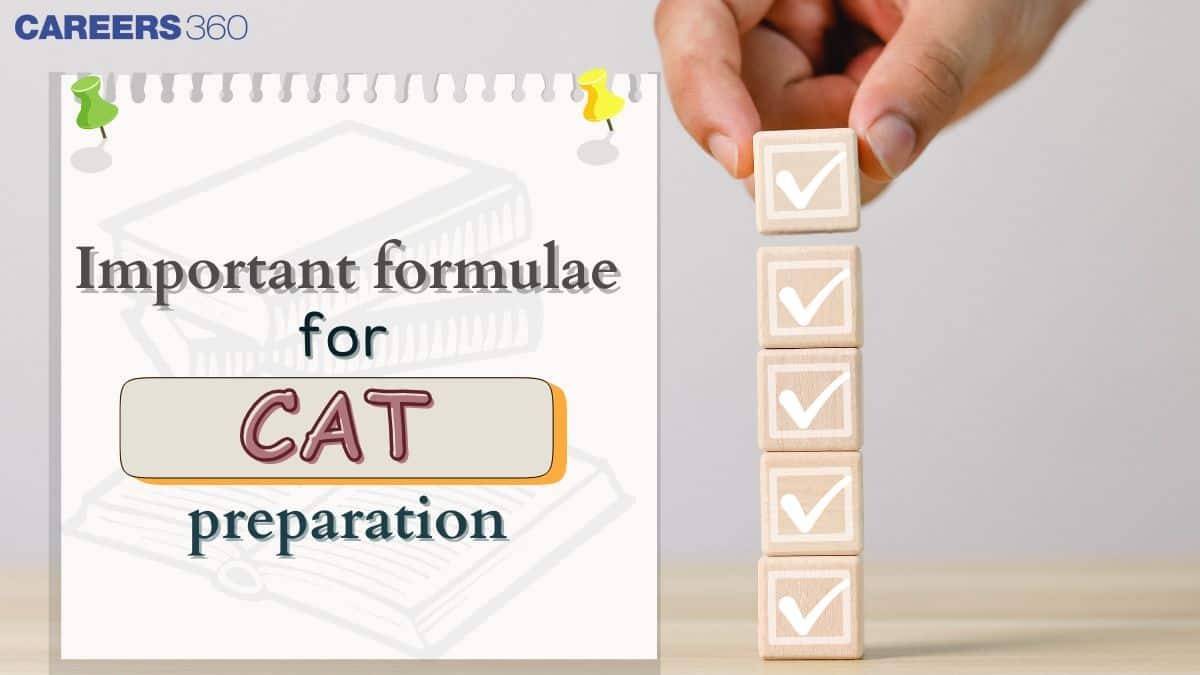
In this article, you will get a free CAT 2025 Formula Sheet PDF along with chapter-wise important Quant formulas, shortcuts, and tips for quick revision.
Download the CAT 2025 formula PDF designed for fast revision and last-minute preparation. This free formula sheet covers all the important formulae that will be helpful to solve questions quickly in the CAT exam.
Download Now: CAT 2025 Important Formulas
Mastering important geometry formulas is crucial for cracking the CAT exam, as geometry is a key topic in the Quantitative Aptitude section. The following section covers all essential CAT geometry formulas, including areas, polygons, angles, and properties of triangles and circles to help you solve problems quickly and accurately.
|
Topic |
Formula |
|
Area of Triangle |
$\frac{1}{2} \times \text{Base} \times \text{Height}$ |
|
Heron's Formula |
$A = \sqrt{s(s-a)(s-b)(s-c)};; s = a + b + c$ |
|
Pythagoras Theorem |
$a^2 + b^2 = c^2\ \text{(for right-angled triangle)}$ |
|
Equilateral Triangle Area |
$3a^2$ |
|
Circumference of Circle |
$2\pi r$ |
|
Area of Circle |
$\pi r^2$ |
|
Length of Arc |
$\dfrac{\theta}{360^{\circ}} \times 2\pi r$ |
|
Area of Sector |
$\dfrac{\theta}{360^{\circ}} \times \pi r^2$ |
|
Area of Rectangle |
$L \times B$ |
|
Perimeter of Rectangle |
$2(L+B)$ |
|
Area of Square |
$a^2$ |
|
Perimeter of Square |
$4a$ |
|
Area of Parallelogram |
$\text{Base} \times \text{Height}$ |
|
Area of Rhombus |
$\dfrac{1}{2} d_1 d_2$ |
|
Sum of Interior Angles |
$(n-2) \times 180^\circ$ |
|
Each Interior Angle (Regular Polygon) |
$\dfrac{(n-2) \times 180^\circ}{n}$ |
|
Each Exterior Angle (Regular Polygon) |
$\dfrac{360^\circ}{n}$ |
|
Surface Area of Sphere |
$4\pi r^2$ |
|
Volume of Sphere |
$\dfrac{4}{3}\pi r^3$ |
|
Surface Area of Cylinder |
$2\pi r(h+r)$ |
|
Volume of Cylinder |
$\pi r^2 h$ |
|
Surface Area of Cone |
$\pi r(r+l)$ |
|
Volume of Cone |
$\dfrac{1}{3}\pi r^2 h$ |
Trigonometry plays a vital role in the CAT Quantitative Aptitude section, making it essential to learn and memorise key formulas. This comprehensive list of important CAT trigonometry formulas helps aspirants solve complex problems with speed, accuracy, and confidence during the exam.
These are defined in relation to a right-angled triangle:
$\sin \theta = \frac{\text{Opposite side}}{\text{Hypotenuse}}$
$\cos \theta = \frac{\text{Adjacent side}}{\text{Hypotenuse}}$
$\tan \theta = \frac{\text{Opposite side}}{\text{Adjacent side}}$
$\csc \theta = \frac{\text{Hypotenuse}}{\text{Opposite side}}$
$\sec \theta = \frac{\text{Hypotenuse}}{\text{Adjacent side}}$
$\cot \theta = \frac{\text{Adjacent side}}{\text{Opposite side}}$
$\sin^2 \theta + \cos^2 \theta = 1$
$1 + \tan^2 \theta = \sec^2 \theta$
$1 + \cot^2 \theta = \csc^2 \theta$
$\sin(-\theta) = -\sin \theta$
$\cos(-\theta) = \cos \theta$
$\tan(-\theta) = -\tan \theta$
$\csc(-\theta) = -\csc \theta$
$\sec(-\theta) = \sec \theta$
$\cot(-\theta) = -\cot \theta$
$\sin(A + B) = \sin A \cos B + \cos A \sin B$
$\sin(A - B) = \sin A \cos B - \cos A \sin B$
$\cos(A + B) = \cos A \cos B - \sin A \sin B$
$\cos(A - B) = \cos A \cos B + \sin A \sin B$
$\tan(A + B) = \frac{\tan A + \tan B}{1 - \tan A \tan B}$
$\tan(A - B) = \frac{\tan A - \tan B}{1 + \tan A \tan B}$
Quantitative Aptitude formulas form the foundation of the Quantitative Aptitude section in the CAT 2025 exam. Here are some important CAT 2025 quant section-wise formulae for CAT 2025 preparation:
The Arithmetic section is the most important section in the Quantitative Aptitude Section, which is also useful to solve the Data Interpretation problems. Following are some 50+ Important Formulas for CAT Preparation of this section which are given in this CAT Formula Sheet:
Following are some Important CAT Formulas of percentage:
$X \text{ is what percentage of } Y = \frac{X}{Y} \times 100$
$X \text{ is what percentage more/less than } Y = \frac{|X - Y|}{Y} \times 100$
Following are some formulas which can be used as CAT Quant Formulae:
|
Concept |
Formula |
|
Successive percentage change |
Overall |
|
Changes in A when B and C are altered |
Overall |
|
Price increase followed by a decrease |
Overall |
Following are some Important CAT Formulas of this topic:
|
Concept |
Formula |
|
Selling Price and Profit |
$S.P. = C.P. + \text{Profit}$ |
|
Selling Price and Loss |
$S.P. = C.P. - \text{Loss}$ |
|
Profit or Loss Percentage |
$\text{Profit or Loss Percentage}$ |
|
Discount Percentage |
$\text{Discount Percentage}$ |
|
Selling Price with Profit or Loss |
$S.P. = \frac{C.P. \times 100 + \text{Profit} \times 100}{100}$ |
|
Selling Price with Profit or Loss |
$S.P. = \frac{C.P. \times 100 - \text{Loss} \times 100}{100}$ |
Following are some basic and Important Formulas for CAT 2025 related to Simple Interest and Compound Interest:
|
Concept |
Formula |
|
Simple Interest |
For Principal ($P$), Rate of Interest ($R$), Time ($T$): $S.I. = P \times R \times T / 100$ |
|
Compound Interest (annually) |
$A = P(1 + \dfrac{R}{100})^n$ where $n$ = time in years. |
|
Compound Interest (half-yearly) |
$A = P \left(1 + \dfrac{R}{2 \times 100}\right)^{2T}$ |
|
Total Amount |
$A = P + \text{Interest}$ |
Following are some formulas which can be used as CAT Quant Formula Cheat Sheet for the preparation and exam point of view:
|
Concept |
Formula |
|
Doubling Time with Compound Interest |
Time to double = $\dfrac{72}{R}$ years (where $R$ = annual interest rate) |
|
Difference Between C.I. and S.I. (2 years) |
$C.I. - S.I. = P \left( \dfrac{R}{100} \right)^2$ |
|
Difference Between C.I. and S.I. (3 years) |
$C.I. - S.I. = P \left( \dfrac{R}{100} \right)^2 \left( 3 + \dfrac{R}{100} \right)$ |
Following are some basic and Important Formulas for CAT 2025 related to Time, Speed and Distance:
|
Concept |
Formula |
|
Distance |
$D = S \times T$ |
|
Average Speed |
$\text{Average Speed} = \dfrac{\text{Total Distance}}{\text{Total Time}}$ |
|
Concept |
Formula |
|
Time for a train to cross a pole/person |
$T = \dfrac{l}{s}$ |
|
Where: $l =$ Length of the train, $s =$ Speed of the train | |
|
Time for a train to cross a platform/tunnel |
$T = \dfrac{l + d}{s}$ |
|
Where: $l =$ Length of the train, $d =$ Length of platform/tunnel, $s =$ Speed of the train | |
|
Time for trains to cross each other (same direction) |
$T = \dfrac{l_1 + l_2}{s_1 - s_2}$ |
|
Where: $l_1, l_2 =$ Lengths of Train 1 and Train 2; $s_1, s_2 =$ Speeds of Train 1 and Train 2 | |
|
Time for trains to cross each other (opposite direction) |
$T = \dfrac{l_1 + l_2}{s_1 + s_2}$ |
|
Where: $l_1, l_2 =$ Lengths of Train 1 and Train 2; $s_1, s_2 =$ Speeds of Train 1 and Train 2 | |
|
Concept |
Formula |
|
Speed of Boat in Still Water |
$x$ kmph |
|
Speed of Stream/Water/Current |
$y$ kmph |
|
Travelling Time |
$t$ hr |
|
Distance (Downstream: same direction) |
$D = (x + y) \times t$ km |
|
Distance (Upstream: opposite direction) |
$D = (x - y) \times t$ km |
|
Concept |
Formula |
|
Speed of Hour Hand |
$0.5^\circ$ per minute |
|
Round covered by Hour Hand |
$1$ round $= 360^\circ$ in $12$ hours or $720$ minutes |
|
Speed of Minute Hand |
$6^\circ$ per minute |
|
Round covered by Minute Hand |
$1$ round $= 360^\circ$ in $1$ hour or $60$ minutes |
|
Angle between Hour and Minute Hands |
$\theta =|\frac{11}{2}M-30H$| |
We have provided below the shortcut formulae related to average speeds, boat stream, circular tracks, meeting point, to make your calculations faster in the CAT 2025 exam.
Case 1: Equal distances, different speeds
If the distance covered in each stage of a journey is the same, but speeds are different, the average speed is the harmonic mean:
$ \text{Average Speed} = \frac{2 s_1 s_2}{s_1 + s_2} $
Example:
Distance from A to B and B to C is the same. Speeds: $s_1$ and $s_2$. Then:
$ \text{Average Speed} = \frac{2 s_1 s_2}{s_1 + s_2} $
Case 2: Equal time, different speeds
If the time taken in each stage is the same but speeds differ, the average speed is the arithmetic mean:
$ \text{Average Speed} = \frac{s_1 + s_2}{2} $
If two people start from the same point on a circular track of length $D$ km with speeds $a$ & $b$ kmph in the same direction:
Time for first meeting:
$ t_{\text{first}} = \frac{D}{|a-b|} $
Time to meet again at the starting point:
$ t_{\text{start}} = \text{LCM}\left(\frac{D}{a}, \frac{D}{b}\right) $
Number of distinct meeting points:
$ \text{Meeting points} = |x - y| $
Where $x:y$ is the simplified ratio of speeds.
Example: If $a = 12$ kmph, $b = 9$ kmph → $x:y = 12:9 = 4:3$ → $x=4$, $y=3$.
If two people start from the same point in opposite directions:
Time for first meeting:
$ t_{\text{first}} = \frac{D}{a+b} $
Time to meet again at the starting point:
$ t_{\text{start}} = \text{LCM}\left(\frac{D}{a}, \frac{D}{b}\right) $
Number of distinct meeting points:
$ \text{Meeting points} = |x + y| $
Where $x:y$ is the simplified ratio of speeds.
If a person $P$ starts from $A$ towards $B$, and $Q$ starts from $B$ towards $A$, and they meet after time $t$:
$ t = x \cdot y $
Where:
$x$ = time taken by $P$ to reach $B$ after meeting
$y$ = time taken by $Q$ to reach $A$ after meeting
If the speed of the boat downstream is $u$ kmph and upstream is $v$ kmph:
Speed of boat in still water:
$ \text{Boat speed} = \frac{u+v}{2} \text{ kmph} $
Rate of stream:
$ \text{Stream speed} = \frac{u-v}{2} \text{ kmph} $
The Geometry section is the lengthiest section in the Quantitative Aptitude Section which has lots of properties and formulas. Following are 50+ Important Formulas for CAT Preparation of this section which are given in this CAT Formula Sheet:
Properties of Triangles:
The sum of all interior angles in a triangle is $180^\circ$ and the sum of all exterior angles is $360^\circ$.
The sum of any two sides is always greater than the third one and the difference of any two sides is less than the third one.
Let $a, b, c$ be the sides of a triangle, then
$|b-c| < a < b+c$
In a scalene triangle the greatest side is always greater than one-third of the perimeter and less than half of the perimeter.
Let $a, b, c$ be the sides of the triangle and $a$ be the greatest side. Let the perimeter be $P$. Then
$\dfrac{P}{3} < a < \dfrac{P}{2}$
Example: In a scalene triangle $ABC$, the perimeter is $24$ cm and all sides are integers.
Let $a, b, c$ be sides of the triangle with $a$ the greatest side. Then
$\dfrac{24}{3} < a < \dfrac{24}{2}$
$8 < a < 12$
So possible values are $9, 10, 11$ cm.
For $a, b, c$ sides of a triangle and $a$ the greatest side:
If $a^2 < b^2 + c^2$, then the triangle is acute angled.
If $a^2 = b^2 + c^2$, then the triangle is right angled (Pythagoras theorem).
If $a^2 > b^2 + c^2$, then the triangle is obtuse angled.
(Here $D$ is the midpoint of side $AC$, so $AD = DC$)
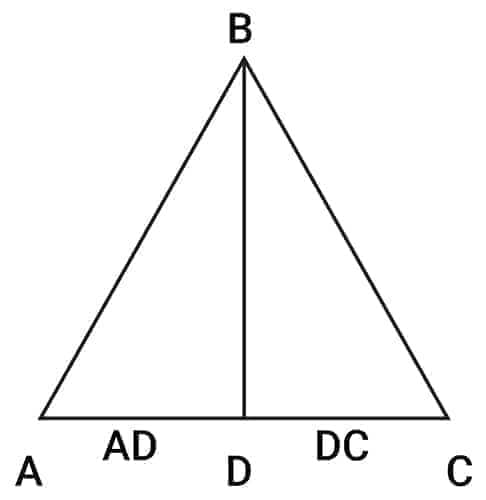
Midpoint of a triangle
Length of the Median –
BD = $\frac12 \sqrt{2(AB^2+BC^2)−AC^2}$
3× (Sum of squares of sides) =4× (Sum of squares of medians), that is,
$3(a^2+b^2+c^2)=4({M_a}^2+{M_b}^2+{M_c}^2)$
where a,b, and c are the sides of the triangle and Ma, Mb, and Mc are the medians.
In a right-angled triangle, Median of Hypotenuse = Half of Hypotenuse
That is,
CD = AB/2
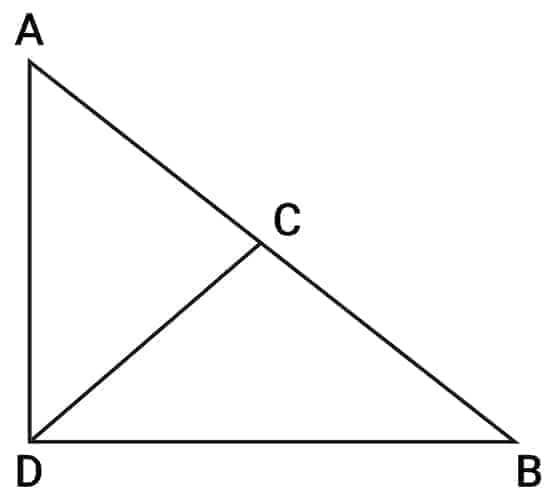
Median of the hypotenuse
If all the medians are drawn in the triangle, then the 6 small triangles are generated in the triangle, which are equal in the Area.
Area of Triangle:
Heron’s Formula
If all sides of a triangle are given. Let $a, b, c$ be the sides of the triangle –
Area $= \sqrt{s(s-a)(s-b)(s-c)}$ where $s = \dfrac{a+b+c}{2}$ is the semiperimeter.
If two sides and the included angle are given –
Area $= \dfrac{1}{2} \times \text{(Product of given sides)} \times \sin(\text{included angle})$
Area $= \dfrac{1}{2} \times a \times b \times \sin C$
(Example: sides $a, b$ and included angle $C$ are given)
If a side and its respective altitude (perpendicular drawn from the opposite vertex) is given, then –
Area of the triangle $= \dfrac{1}{2} \times \text{Base} \times \text{Height (Altitude)}$
Area of an equilateral triangle = $ \frac{\sqrt{3}}{4} a^2 $
Height (Altitude) of an equilateral triangle = $ \frac{\sqrt{3}}{2} a $
Area of a triangle = $ r \times s $ (where $r$ is the inradius and $s$ is the semiperimeter)
Area of a triangle = $ \frac{abc}{4R} $ (where $a$, $b$, $c$ are sides and $R$ is the circumradius)
|
Trapezium
|
Area: $ \frac{1}{2} \times (\text{Sum of Parallel Sides}) \times \text{Height} $ |
|
Parallelogram
|
Opposite angles and sides are equal. |
|
Rhombus
|
All sides and opposite angles are equal. Diagonals bisect each other at 90∘. Sum of squares of diagonals: $ 4a^2 $ Where: |
|
Rectangle |
Perimeter: $ 2(l + b) $ (where $l =$ length, $b =$ breadth) |
|
Square |
Perimeter: $ 4a $ (where $a =$ side of square) |
|
Cyclic Quadrilateral
|
$\text{Sum of opposite angles} = 180^\circ$ $\text{Area} = \frac{1}{2} \times d_1 \times d_2 \times \sin \theta \quad \text{(where } \theta \text{ is the angle between the diagonals)}$ $\text{Area} = (s - a)(s - b)(s - c)(s - d), \quad \text{where } a,b,c,d \text{ are sides and } s = \frac{a + b + c + d}{2} \text{ is the semi-perimeter}.$ |
Circumference of a circle $= 2\pi r$
Area of a circle $= \pi r^2$
For a semi-circle:
Circumference of a semi-circle $= \pi r$
Perimeter of a semi-circle $= \pi r + 2r$
Area of a semi-circle $= \dfrac{\pi r^2}{2}$
Sector & Segment of a circle
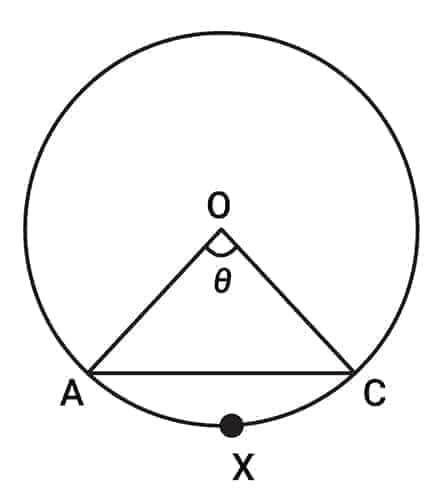
$OAXC$ is called the sector of the circle and $AXC$ is called the segment.
Length of arc $AXC = \dfrac{\theta}{360} \times 2\pi r$ (where $r$ is the radius)
Area of sector $OAXC = \dfrac{\theta}{360} \times \pi r^2$
$2 \times \text{Area of sector} = \text{Length of arc} \times \text{Radius}$
Area of segment $AXC = \text{Area of sector } OAXC - \text{Area of } \triangle OAC$
$A = \dfrac{\theta}{360} \pi r^2 - \dfrac{1}{2} r^2 \sin \theta$
Where:
$\theta$ = angle subtended at the center (in degrees)
$r$ = radius of the circle
$PQ$ and $RS$ are the direct common tangents of the circles, which are equal in length.
Length of direct common tangent $(L)$:
$L^2 = d^2 - (r_1 - r_2)^2$
Where:
$d =$ distance between centers of the circles
$r_1, r_2 =$ radii of the circles
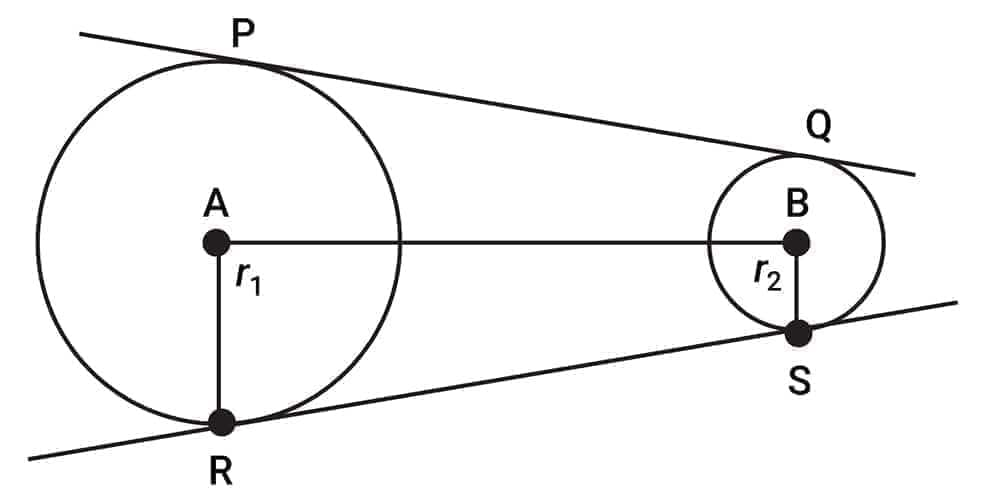
$PQ$ and $RS$ are the transverse common tangents of the circles, which are equal in length.
Length of transverse common tangent $(L)$:
$L^2 = d^2 - (r_1 + r_2)^2$
Where:
$L =$ length of the transverse common tangent
$d =$ distance between the centers of the two circles
$r_1, r_2 =$ radii of the two circles
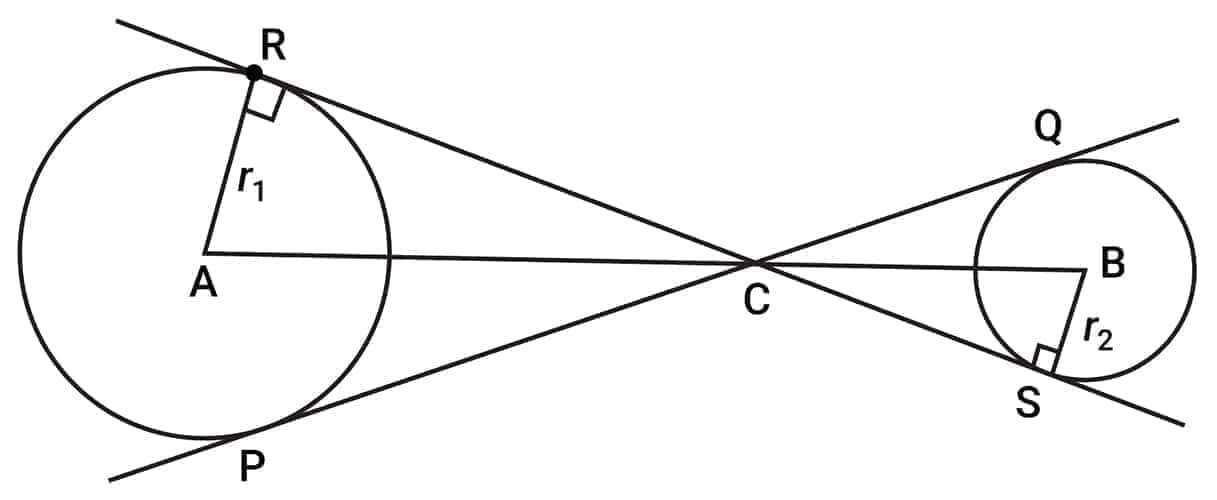
|
Cube {a- side of cube} |
Let a be the side of the cube:
|
|
Cuboid {l-length, b-breadth, h-height} |
Let l = length, b = breadth, h = height:
|
|
Cylinder {r-radius of circular base, h-height} |
Let r = radius of base, h = height:
|
|
Cone {r-radius of circular base, h-height, l- slant height} |
Curved Surface Area (C.S.A.): $ \pi r l $ Total Surface Area (T.S.A.): $ \pi r (r + l) $ Volume: $ \frac{1}{3}\pi r^2 h $ Where: |
|
Sphere {r-radius} |
Total Surface Area: $ 4\pi r^2 $ Volume: $ \frac{4}{3} \pi r^3 $ Where r is the radius. |
|
Hemi-sphere {r-radius} |
Let r be the radius:
|
The Algebra section is a critical part of the Quantitative Aptitude section in the CAT exam. Below are over 50 important formulas for CAT preparation in this section, which are provided in this comprehensive CAT Formula Sheet:
1. Quadratic Equations
General form:
$ ax^2 + bx + c = 0 $
Roots of the equation (Shreedhara Acharya's Formula):
$ x = \frac{-b \pm \sqrt{b^2 - 4ac}}{2a} $
Sum of roots:
$ \text{Sum} = -\frac{b}{a} $
Product of roots:
$ \text{Product} = \frac{c}{a} $
Discriminant:
$ D = b^2 - 4ac $
If $D > 0$, roots are real and distinct
Perfect square $D$ → roots are rational (e.g., $x=1,6$)
Non-perfect square $D$ → roots are irrational/conjugate surds (e.g., $x = 3 - \sqrt{5}, 3 + \sqrt{5}$)
If $D = 0$, roots are real and equal
If $D < 0$, roots are imaginary and distinct
Vertex (Maximum/Minimum values):
For $y = ax^2 + bx + c$, $a>0$ (Minimum):
$ x = -\frac{b}{2a}, \quad y_{\text{min}} = -\frac{D}{4a} $
For $y = ax^2 + bx + c$, $a<0$ (Maximum):
$ x = -\frac{b}{2a}, \quad y_{\text{max}} = -\frac{D}{4a} $
Quadratic equation from roots $a$ and $b$:
$ x^2 - Sx + P = 0 $, where $ S = a+b $, $ P = ab $
Or equivalently:
$ x^2 - (a+b)x + ab = 0 $
Arithmetic Progression (A.P.)
If a is the first term and d is the common difference then the Arithmetic Progression (A.P.). can be written as-
a, a+d, a+2d, a+3d, …
Let $a =$ first term
$d =$ common difference
$n$ = number of terms
Nth term of the A.P. –
$T_n = a + (n-1)d$
Sum of the first $n$ terms of the A.P. $(S_n)$ = Average of all the terms $\times$ number of terms $(n)$.
The average of the terms can be found easily:
If the number of terms is odd, then the middle term will be the average.
Example: $2, 5, 8, 11, 14$ are terms of the A.P., then the middle term $8$ is the average.
So, $S_n = \text{average} \times n = 8 \times 5 = 40$.
If the number of terms is even, then the average of the middle two terms will be the average of the A.P.
Formula for the sum of $n$ terms:
$S_n = \dfrac{n}{2} \big[ 2a + (n-1)d \big]$
$S_n = \dfrac{n}{2}(a+l)$ (where $a =$ first term, $l =$ last term, $n =$ number of terms)
$n = \dfrac{l-a}{d}+1$ (number of terms in A.P.)
Geometric Progression (G.P.)
If $a$ is the first term and $r$ is the common ratio, then the G.P. can be written as: $a, ar, ar^2, ar^3, \dots$
Nth term of the G.P.: $T_n = a \cdot r^{n-1}$
Sum of the first $n$ terms:
If $|r| < 1$: $S_n = a \cdot \dfrac{1-r^n}{1-r}$
If $r > 1$: $S_n = a \cdot \dfrac{r^n-1}{r-1}$
Sum of infinite terms of the G.P. (if $|r|<1$): $S_\infty = \dfrac{a}{1-r}$
Where: $a =$ first term, $r =$ common ratio, $n =$ number of terms
$|r|<1$ ensures the series converges.
If there are odd no. of terms in a G.P., then the product of all terms are equal to the nth power of the middle term.
e.g. 2,6,18,54,162 are the terms of a G.P.
Then the products of all the terms = 185
Harmonic Progression (H.P.)
If a,b,c are in A.P., then $\frac{1}{a},\frac{1}{b},\frac{1}{c}$ are in Harmonic Progression (H.P.).
n-th term of the H.P.=$\frac{1}{n}$-th term of the corresponding A.P.
Sum of first $n$ natural numbers:
$ 1 + 2 + 3 + \cdots + n = \frac{n(n+1)}{2} $
Sum of squares of first $n$ natural numbers:
$ 1^2 + 2^2 + 3^2 + \cdots + n^2 = \frac{n(n+1)(2n+1)}{6} $
Sum of cubes of first $n$ natural numbers:
$ 1^3 + 2^3 + 3^3 + \cdots + n^3 = \left(\frac{n(n+1)}{2}\right)^2 $
Sum of first $n$ odd numbers:
$ 1 + 3 + 5 + \cdots + (2n-1) = n^2 $
Sum of squares of first $n$ even numbers:
$ 2^2 + 4^2 + 6^2 + \cdots + (2n)^2 = \frac{2n(n+1)(2n+1)}{3} $
Sum of squares of first $n$ odd numbers:
$ 1^2 + 3^2 + 5^2 + \cdots + (2n-1)^2 = \frac{n(2n+1)(2n-1)}{3} $
Product Rule:
$ a^m \cdot a^n = a^{m+n} $
Quotient Rule:
$ \frac{a^m}{a^n} = a^{m-n} $
Power of a Power:
$ (a^m)^n = a^{mn} $
Power of a Product:
$ (ab)^n = a^n \cdot b^n $
Power of a Quotient:
$ \left(\frac{a}{b}\right)^n = \frac{a^n}{b^n} $
Negative Exponent:
$ a^{-n} = \frac{1}{a^n} $
Infinite Product: $\prod_{n=1}^{\infty} a_n = \lim_{n \to \infty} \prod_{k=1}^{n} a_k$
Definition of Logarithm:
$ \log_b a = x ;;\Longleftrightarrow;; b^x = a $
Log of 1:
$ \log_b 1 = 0 \quad (b>0, ; b \neq 1) $
Log of the base itself:
$ \log_b b = 1 $
Log of a product:
$ \log_b (mn) = \log_b m + \log_b n $
Log of a quotient:
$ \log_b \left(\frac{m}{n}\right) = \log_b m - \log_b n $
Log of a power:
$ \log_b (m^n) = n \cdot \log_b m $
Change of base formula:
$ \log_b a = \frac{\log_k a}{\log_k b} $
Base switch rule:
$ \log_a b = \frac{1}{\log_b a} $
The CAT 2025 Quantitative Aptitude Cheat Sheet PDF is a compact, high-utility resource covering all essential formulas, theorems, and shortcuts from Arithmetic, Algebra, Geometry, Modern Math, and Number Systems. It’s designed for rapid revision and accuracy improvement during mock tests. Students can quickly recall percentage-to-ratio conversions, time–speed–distance relationships, and equation-solving tricks. The CAT Quant formula sheet PDF also includes sectional difficulty markers and formula interlinks to help identify topic dependencies. Thus, it helps in last-minute prep and stronger conceptual recall during the CAT QA section.
Download Now: CAT 2025 Quantitative Aptitude Cheat Sheet PDF
A CAT 2025 formula sheet acts as a quick reference guide during preparation. It helps you recall key concepts, save revision time, and improve accuracy in problem-solving. Having all important formulas from Arithmetic, Algebra, Geometry, and Modern Math in one place boosts your speed and confidence while attempting Quantitative Aptitude questions in the exam.
A well-organised CAT formula sheet allows you to revise important concepts quickly before mocks and the final exam. Instead of searching through multiple books or notes, you can go through one sheet that covers all crucial formulas from Arithmetic, Algebra, Geometry, and Numbers. This structured revision helps you improve speed and problem-solving efficiency.
Preparing a formula sheet for CAT 2025 preparation builds a stronger understanding of topics. Writing and categorising formulas by section—like percentages, ratios, or permutations—helps you connect ideas and recall the right one during tough questions. This approach ensures both clarity and application accuracy in the actual exam.
Many students make small calculation errors due to confusion between similar formulas. Regularly revising from your CAT Quant formula sheet helps you retain correct equations and avoid mix-ups. Clear understanding of formula derivations enhances precision, reducing the chances of negative marking in the test.
Using a CAT formula sheet during mock test practice can significantly improve your score. Reviewing it before and after each mock boosts memory retention and highlights weak areas. You can track which formulas you forget often and revise them again—turning your mock analysis into a more effective learning process.
Before appearing for CAT 2025, revising all key formulas from your sheet gives a psychological advantage. It helps calm nerves, refresh memory, and strengthen exam confidence. A personalised, well-maintained formula sheet acts like a final preparation guide, ensuring you enter the exam hall fully prepared.
A CAT Quant formula sheet is one of the smartest ways to simplify exam preparation. It helps you revise essential formulas, identify weak areas, and boost problem-solving speed. With quick access to all important concepts, aspirants can focus better, reduce last-minute stress, and improve their CAT 2025 Quantitative Aptitude performance significantly.
The CAT 2025 Quant formula sheet collects all key formulas in one place—covering Arithmetic, Algebra, Geometry, and Modern Math. Instead of flipping through books, you can revise every crucial concept quickly. This saves time and helps maintain consistent practice, ensuring you remember formulas even under exam pressure.
Remembering formulas accurately is essential for speed-based exams like CAT 2025. Regular revision from your Quant formula sheet helps you apply equations faster, solve complex problems efficiently, and attempt more questions in less time. This habit can make a major difference in your sectional and overall percentile.
A personalised CAT Quant formula sheet strengthens your recall and clarity. When you know which formula fits each question type, you reduce silly mistakes and confusion. Repeatedly reviewing and testing yourself on these formulas improves accuracy, especially in topics like Time-Speed-Distance, Profit-Loss, and Probability.
During the final days before CAT 2025, revising entire books isn’t practical. Your Quant formula sheet becomes the ultimate quick revision guide. It helps you brush up on important equations and shortcuts in a few hours, keeping your memory fresh right before the exam.
While updating your CAT 2025 Quantitative Aptitude formula sheet, you’ll naturally notice which topics you often skip or forget. This helps in analysing your weaker areas early and focusing your preparation accordingly. Over time, it turns into a powerful self-assessment and improvement tool for CAT aspirants.
The CAT 2025 Quantitative Aptitude section tests both accuracy and speed. Since most questions rely on direct formula application, mastering and retaining formulas from Arithmetic, Algebra, Geometry, Modern Math, and Number Systems is crucial. Using smart memorisation techniques like spaced repetition, topic clustering, and visual recall helps improve long-term retention and boosts problem-solving efficiency during mocks and the actual CAT exam.
Spaced repetition helps strengthen memory through periodic reviews. Use digital tools like Anki or Notion flashcards to revise formulas at increasing intervals—1 day, 3 days, 7 days, and 15 days. This scientifically proven method ensures that key CAT Quant formulas (like simple and compound interest, quadratic roots, and geometry area relations) stay fresh and accessible during timed tests.
Divide formulas by topic, Arithmetic (Percentages, Ratios, Averages), Algebra (Equations, Inequalities), Geometry (Circles, Triangles, Mensuration)—and maintain a concise sheet for each. This topic-wise segregation improves focused revision and pattern recognition, making it easier to recall related concepts together during CAT 2025 QA problem-solving. Keep each sheet concise with examples and shortcut notes for quick scanning.
Retention improves when formulas are applied regularly. Practice 5–10 formula-based questions daily from mock papers or sectional tests. For instance, when revising Time–Speed–Distance, solve both basic and mixed-level problems to understand contextual application. Continuous exposure helps bridge the gap between theoretical knowledge and practical problem-solving during CAT’s high-pressure environment.
Visual learning techniques improve recall under exam stress. Create mind maps, flowcharts, or acronym-based mnemonics for formula clusters (like SOH–CAH–TOA for trigonometry). Use color-coded notes to differentiate between formula types—geometry in blue, algebra in green, arithmetic in red. These cues help visually trigger recall during CAT Quantitative Aptitude questions.
After every mock or sectional test, review formulas linked to incorrect or time-consuming questions. Maintain a Formula Revision Log that tracks which formulas caused confusion or slow recall. Revisit and reapply these during subsequent practice sessions. This iterative feedback loop ensures you don’t just memorise but also master CAT 2025 Quant formulas through active error correction.
A well-organized formula sheet can drastically improve preparation efficiency:
Arrange formulas chapter-wise: Arithmetic, Algebra, Geometry, Number System, Modern Maths.
Highlight high-importance formulas using color or bold text.
Include small diagrams for Geometry and Trigonometry to aid visual memory.
Maintain either a physical notebook or a digital file for easy access.
Compile a one-page PDF of essential formulas for quick last-minute revision.
IBSAT 2025-Your gateway to MBA/PGPM @ IBS Hyderabad and 8 other IBS campuses | Scholarships worth 10 CR
Highest Package 27.25 LPA | Top 100 Average package 16.65 LPA | AACSB Accredited | Ranked 52 by QS International
This approach ensures all key formulas are available at your fingertips, making your study time highly productive.
Explore the best CAT 2025 eBooks and study materials recommended by experts for complete preparation. These resources will help aspirants revise efficiently and boost exam preparation.
|
Title |
Download Link |
|
CAT 2025 Quantitative Aptitude 20 Free Sectional Tests | |
|
CAT 2025 Arithmetic Important Concepts and Practice Questions | |
|
CAT 2025 Algebra Important Concepts and Practice Questions | |
|
CAT 2025 Quantitative Aptitude Study Material PDF - Geometry and Mensuration | |
|
CAT 2025 Number System Important Concepts and Practice Questions | |
|
CAT 2025 Quantitative Aptitude Questions with Answers PDF |
Frequently Asked Questions (FAQs)
Yes, formulas like LCM × HCF = Product of numbers and sum of series are important. Examples: sum of first n natural numbers n(n+1)/2 and squares n(n+1)(2n+1)/6. Divisibility rules also save time in CAT questions.
Absolutely. Many aspirants successfully prepare using self-study materials, previous year papers, and practice tests. Discipline and a well-structured study plan are key to self-preparation.
You don’t need every formula ever made—just focus on those repeatedly asked in previous CAT papers. Prioritise core areas like Arithmetic, Algebra, and Geometry for best results.
Write formulas in a separate notebook or digital sheet, revise them daily, and practise topic-wise questions. Repetition through mock tests helps build long-term memory and faster recall during the exam.
A well-organised CAT formula sheet saves revision time, prevents confusion, and improves problem-solving speed. It’s especially useful for last-minute revision before mocks and the final CAT exam.
You can create your own sheet from trusted CAT preparation books or refer to online resources like Careers360 and coaching material that list CAT 2025 topic-wise formulas for quick reference.
Key formulas include percentages, profit and loss, time-speed-distance, averages, simple and compound interest, geometry theorems, and algebraic identities. These formulas help solve most Quant questions quickly and accurately in CAT 2025.
Yes, NCERT books, particularly for subjects like Mathematics, provide a solid foundation. They are especially beneficial for beginners to grasp basic concepts before moving to more complex materials.
Important formulas are Area of Circle (πr²), Circumference (2πr), and Pythagoras theorem (a² + b² = c²). Triangle area ½ × base × height and Volume of Cylinder (πr²h) are also common. CAT Geometry questions depend directly on these.
On Question asked by student community
Hello,
With a projected CAT percentile of 87% but not clearing sectional cutoffs, your chances at top IIMs are limited because they require both overall percentile and sectional minimums. However, you still have a good shot at other reputed management institutes and non-IIM B-schools. Consider colleges like NMIMS, SPJIMR, IMT, TAPMI, Great Lakes, and other well-ranked private or state-level B-schools that accept CAT scores and weigh your profile holistically. Your academic record, BSc in Animation with 80%, and 5 years of work experience at Ubisoft India are strong points and may help in institutes that value work experience in their selection process. Also, explore institutes that accept XAT, MAT, or CMAT, where your profile can be competitive.
Hope this helps you.
Good Morning,
NIT Rourkela CAT cutoff range is between 70-85 percentiles for the general category. 70 is the minimum percentile needed to apply, and 85 is the highest percentile. However, the maximum percentile depends on the particular year competition. It can be changed.
Thank You.
If you filled the UGC NET form under EWS but you don’t have a valid EWS certificate, then forget using the EWS category. They won’t accept it. You’ll automatically be treated as General category during document verification.
And no, this won’t make your form “invalid” or “illegal.” It just means you won’t get the EWS benefit.
So yes — you can still go for General category posts and Professor recruitment. Just don’t try to submit a fake/invalid certificate; that will get you disqualified.
Hello,
If your CAT admit card shows your surname first followed by your first name as entered in the form, it is correct. You do not need to worry about this format as long as it matches the details you provided. Ensure all other information on the admit card is accurate and carry it to the exam along with the required identification documents.
Hope this helps you.
Hello,
If your CAT admit card has a different date of birth than your Aadhaar card, you should get it corrected immediately . Here’s what you can do:
Check the CAT website : Log in to your candidate portal and look for the option to correct personal details.
Contact the CAT helpdesk : Email or call them explaining the issue. Attach a copy of your Aadhaar card as proof.
Do not ignore it : The date of birth must match your ID, otherwise you may face problems at the exam or during admission.
Usually, the CAT authorities allow corrections before the exam, so act quickly.
Hope it helps !
Globally Recognized by AACSB (US) & AMBA (UK) | 17.8 LPA Avg. CTC for PGPM 2025
Top 30 Private B-Schools Nationally and Top 3 in Gujarat | Highest CTC- 20 LPA | Average CTC- 8.4 LPA | 40% Pre-Placement Offers | 670+ Recruiters
UGC Approved Programs | Near 100% Placement Record | Up to 100% Scholarships | Highest CTC 21.32 LPA
Highest CTC 51.38 LPA | Median CTC 10.32 LPA | Top 25% Average CTC 14.32 LPA
Ranked among top 10 B-Schools in India by multiple publications | Top Recruiters-Google, MicKinsey, Amazon, BCG & many more.
EFMD Accredited | AACSB & Business Graduates Association Member | Highest CTC 19 LPA | Application Closing on 7th Jan'26